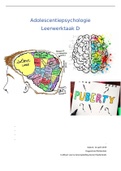College aantekeningen
ATP tutorial Class notes Physiology Of Microorganisms Brock Biology of Microorganisms plus Pearson Mastering Microbiology with Pearson eText, Global Edition, ISBN: 9781292235226
- Instelling
- Radboud Universiteit Nijmegen (RU)
This document covers one of the lectures given during a tutorial about ATP.
[Meer zien]














